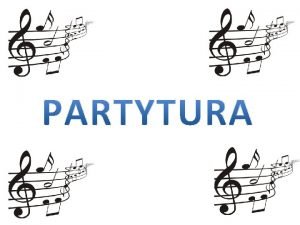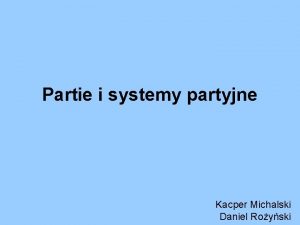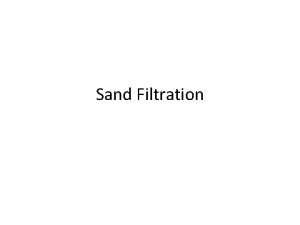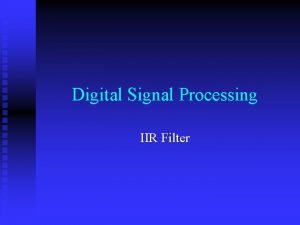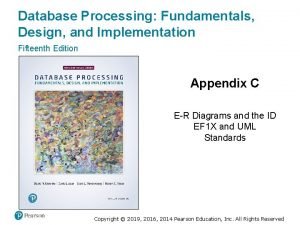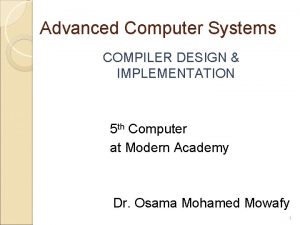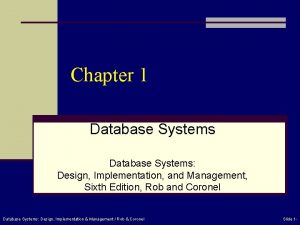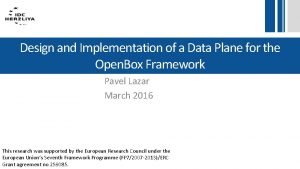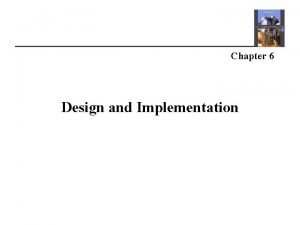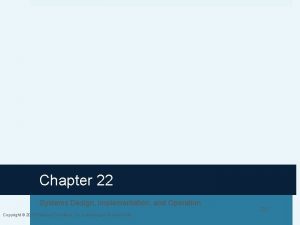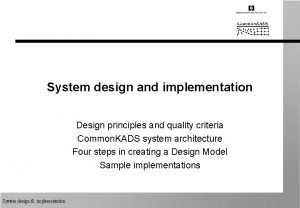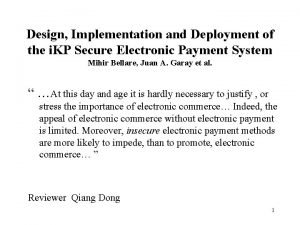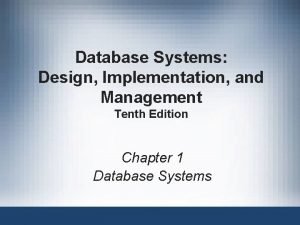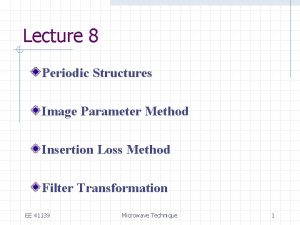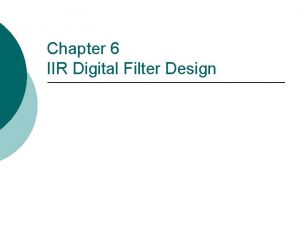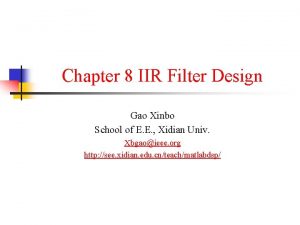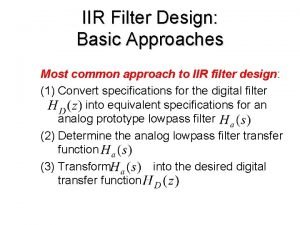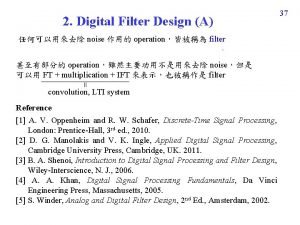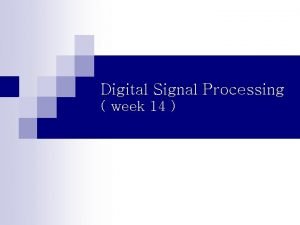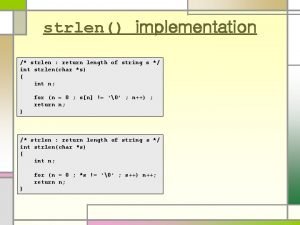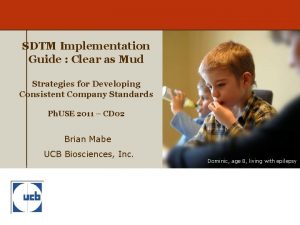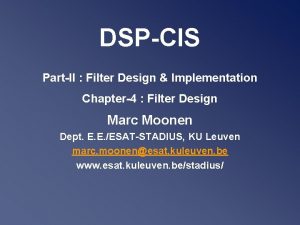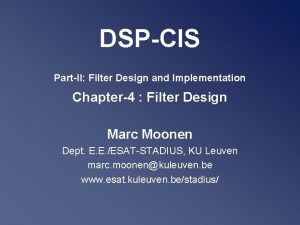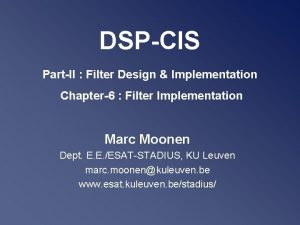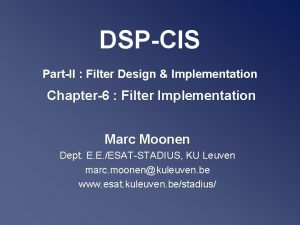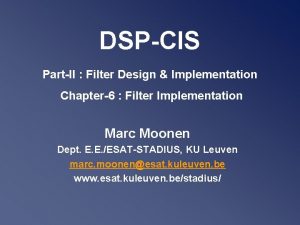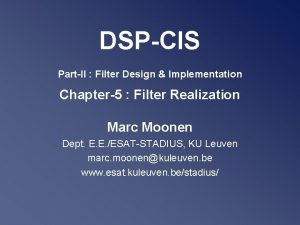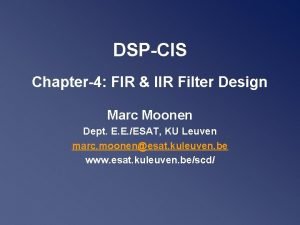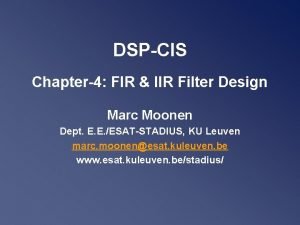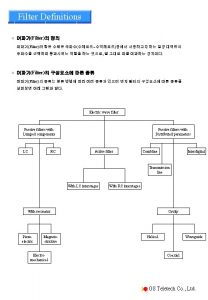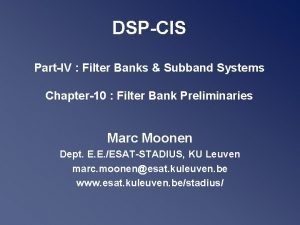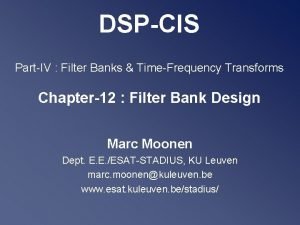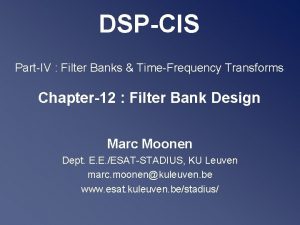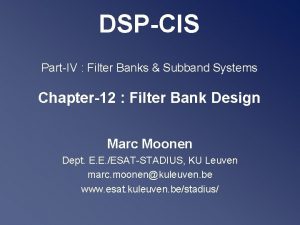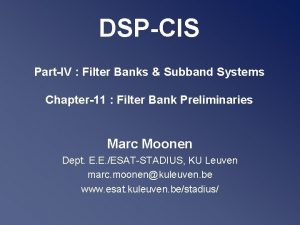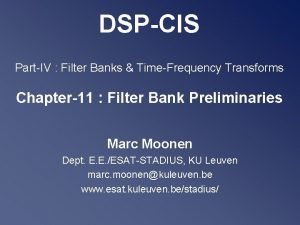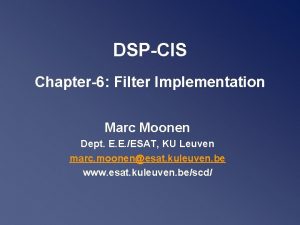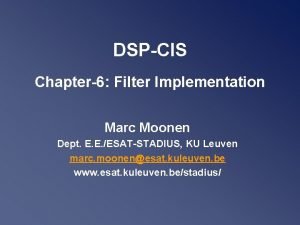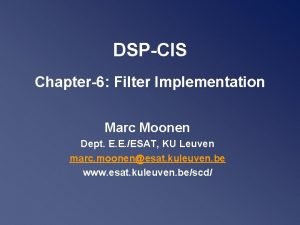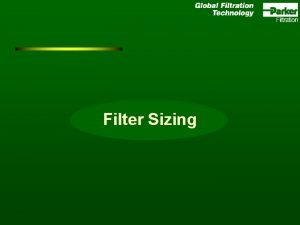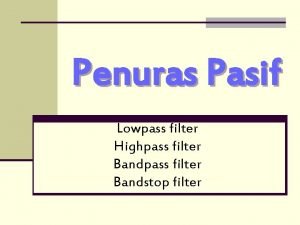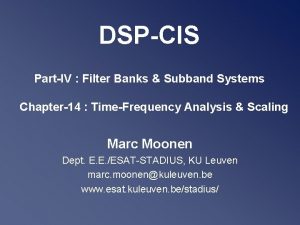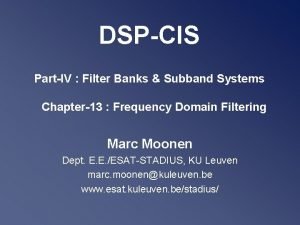DSPCIS PartII Filter Design Implementation Chapter4 Filter Design







![Linear Phase FIR Filters Type-1 L=2 Lo=even symmetric h[k]=h[L-k] Type-2 L=2 Lo+1=odd h[k]=h[L-k] h[k]=-h[L-k] Linear Phase FIR Filters Type-1 L=2 Lo=even symmetric h[k]=h[L-k] Type-2 L=2 Lo+1=odd h[k]=h[L-k] h[k]=-h[L-k]](https://slidetodoc.com/presentation_image_h/f66ccc6d1da323230125043347cdce8b/image-8.jpg)
































- Slides: 40

DSP-CIS Part-II : Filter Design & Implementation Chapter-4 : Filter Design Marc Moonen Dept. E. E. /ESAT-STADIUS, KU Leuven marc. moonen@kuleuven. be www. esat. kuleuven. be/stadius/

Filter Design Process • Step-1 : Define filter specs Pass-band, stop-band, optimization criterion, … • Step-2 : Derive optimal transfer function FIR or IIR filter design Chapter-4 • Step-3 : Filter realization (block scheme/flow graph) Direct form realizations, lattice realizations, … Chapter-5 • Step-4 : Filter implementation (software/hardware) Finite word-length issues, … Chapter-6 Question: implemented filter = designed filter ? ‘You can’t always get what you want’ -Jagger/Richards (? ) DSP-CIS 2017 / Part-II / Chapter-4: Filter Design 2 / 40

Filter Design Process • Step-1: Filter Specification Example: Low-pass filter DSP-CIS 2017 / Part-II / Chapter-4: Filter Design 3 / 40

Chapter-4 : Filter Design • FIR filters – Linear-phase FIR filters – FIR design by optimization Weighted least-squares design, Minimax design – FIR design in practice `Windows’, Equiripple design, … Software (Matlab, …) • IIR filters – Poles and zeros – IIR design by optimization Weighted least-squares design, Minimax design – IIR design in practice Software (Matlab, …) DSP-CIS 2017 / Part-II / Chapter-4: Filter Design 4 / 40

FIR Filters FIR filter = finite impulse response filter • L poles at the origin z=0 (hence guaranteed stability) • L zeros (zeros of B(z)), `all zero’ filters • Corresponds to difference equation • Hence also known as `moving average filters’ (MA) • Impulse response DSP-CIS 2017 / Part-II / Chapter-4: Filter Design 5 / 40

Linear Phase FIR Filters • Non-causal zero-phase filters : Example: symmetric impulse response (length 2. Lo+1) h[-Lo], …. h[-1], h[0] , h[1], . . . , h[Lo] h[k]=h[-k], k=1. . Lo Lo k Frequency response is 2 Lo+1 terms i. e. real-valued (=zero-phase) transfer function DSP-CIS 2017 / Part-II / Chapter-4: Filter Design 6 / 40

Linear Phase FIR Filters • Causal linear-phase filters = non-causal zero-phase + delay Example: symmetric impulse response & L even h[0], h[1], …. , h[L] L=2. Lo h[k]=h[L-k], k=0. . L k 0 L Frequency response is = i. e. causal implementation of zero-phase filter, by introducing delay DSP-CIS 2017 / Part-II / Chapter-4: Filter Design phase is linear function of frequency 7 / 40
![Linear Phase FIR Filters Type1 L2 Loeven symmetric hkhLk Type2 L2 Lo1odd hkhLk hkhLk Linear Phase FIR Filters Type-1 L=2 Lo=even symmetric h[k]=h[L-k] Type-2 L=2 Lo+1=odd h[k]=h[L-k] h[k]=-h[L-k]](https://slidetodoc.com/presentation_image_h/f66ccc6d1da323230125043347cdce8b/image-8.jpg)
Linear Phase FIR Filters Type-1 L=2 Lo=even symmetric h[k]=h[L-k] Type-2 L=2 Lo+1=odd h[k]=h[L-k] h[k]=-h[L-k] LP/HP/BP zero at LP/BP zero at HP/BP symmetric Type-3 L=2 Lo=even anti-symmetric Type-4 L=2 Lo+1=odd anti-symmetric PS: `Modulating’ Type-2 with 1, -1, . . gives Type-4 (LP->HP) PS: `Modulating’ Type-4 with 1, -1, . . gives Type-2 (HP->LP) PS: `Modulating’ Type-1 with 1, -1, . . gives Type-1 (LP<->HP) PS: `Modulating’ Type-3 with 1, -1, . . gives Type-3 (BP<->BP) PS: IIR filters can NEVER have linear-phase property ! (proof see literature) DSP-CIS 2017 / Part-II / Chapter-4: Filter Design 8 / 40

FIR Filter Design by Optimization (I) Weighted Least Squares Design : • Select one of the basic forms that yield linear phase e. g. Type-1 • Specify desired frequency response (LP, HP, BP, …) • Optimization criterion is where is a weighting function DSP-CIS 2017 / Part-II / Chapter-4: Filter Design 9 / 40

FIR Filter Design by Optimization • …This is equivalent to = `Quadratic Optimization’ problem DSP-CIS 2017 / Part-II / Chapter-4: Filter Design 10 / 40

FIR Filter Design by Optimization • Example: Low-pass design Optimization function is i. e. DSP-CIS 2017 / Part-II / Chapter-4: Filter Design 11 / 40

FIR Filter Design by Optimization • A simpler problem is obtained by replacing the F(. . ) by… where the wi’s are a set of sample frequencies This leads to an equivalent (`discretized’) quadratic optimization function: Compare to p. 10 +++ Simple - - - Unpredictable behavior in between sample freqs. DSP-CIS 2017 / Part-II / Chapter-4: Filter Design 12 / 40

FIR Filter Design by Optimization • This is often supplemented with additional constraints, e. g. for pass-band stop-band ripple control : • The resulting optimization problem is : minimize : (=quadratic function) subject to (=pass-band constraints) (=stop-band constraints) = `Quadratic Programming’ problem DSP-CIS 2017 / Part-II / Chapter-4: Filter Design 13 / 40

FIR Filter Design by Optimization (II) `Minimax’ Design : • Select one of the basic forms that yield linear phase e. g. Type-1 • Specify desired frequency response (LP, HP, BP, …) • Optimization criterion is where • is a weighting function Leads to `Semi-Definite Programming’ (SDP) problem, for which efficient interior-point algorithms & software available. DSP-CIS 2017 / Part-II / Chapter-4: Filter Design 14 / 40

FIR Filter Design by Optimization • Conclusion: (I) Weighted least squares design (II) Minimax design provide general `framework’, procedures to translate filter design problems into standard optimization problems • In practice (and in textbooks): Emphasis on specific (ad-hoc) procedures : - Filter design based on `windows’ - Equiripple design DSP-CIS 2017 / Part-II / Chapter-4: Filter Design 15 / 40

FIR Filter Design using `Windows’ Example : Low-pass filter design • Ideal low-pass filter is • Hence ideal time-domain impulse response is (non-causal zero-phase) • Truncate hd[k] to L+1 samples (L even): • Add delay to turn into causal filter DSP-CIS 2017 / Part-II / Chapter-4: Filter Design 16 / 40

FIR Filter Design using `Windows’ Example : Low-pass filter design (continued) • PS : It can be shown (use Parceval’s theorem) that the filter obtained by such time-domain truncation is also obtained by using a weighted least-squares design procedure with the given Hd, and weighting function • Truncation corresponds to applying a `rectangular window’ : • +++ Simple procedure (also for HP, BP, …) • - - - Truncation in time-domain results in `Gibbs effect’ in frequency domain, i. e. large ripple in pass-band stop-band (at band edge discontinuity), which cannot be reduced by increasing the filter order L. DSP-CIS 2017 / Part-II / Chapter-4: Filter Design 17 / 40

FIR Filter Design using `Windows’ Remedy: Apply other window functions… • Time-domain multiplication with a window function w[k] corresponds to frequency domain convolution with W(z) : • Candidate windows : Han, Hamming, Blackman, Kaiser, …. (see textbooks, see DSP-I) • Window choice/design = trade-off between side-lobe levels (define peak pass-/stop-band ripple) and width main-lobe (defines transition bandwidth), see examples p. 25 -28 DSP-CIS 2017 / Part-II / Chapter-4: Filter Design 18 / 40

FIR Equiripple Design • Starting point is minimax criterion, e. g. • Based on theory of Chebyshev approximation and the `alternation theorem’, which (roughly) states that the optimal d’s are such that the `max’ (maximum weighted approximation error) is obtained at Lo+2 extremal frequencies… …that hence will exhibit the same maximum ripple (`equiripple’) • Iterative procedure for computing extremal frequencies, etc. (Remez exchange algorithm, Parks-Mc. Clellan algorithm) • Very flexible, etc. , available in many software packages • Details omitted here (see textbooks) DSP-CIS 2017 / Part-II / Chapter-4: Filter Design 19 / 40

FIR Filter Design Software • FIR Filter design abundantly available in commercial software • Matlab: b=fir 1(L, Wn, type, window), windowed linear-phase FIR design, L is filter order, Wn defines band-edges, type is `high’, `stop’, … b=fir 2(L, f, m, window), windowed FIR design based on inverse Fourier transform with frequency points f and corresponding magnitude response m b=remez(L, f, m), equiripple linear-phase FIR design with Parks-Mc. Clellan (Remez exchange) algorithm DSP-CIS 2017 / Part-II / Chapter-4: Filter Design 20 / 40

FIR Filter Design – Matlab Examples for filter_order=10: 30: 100 % Impulse response b = fir 1(filter_order, [W 1 W 2], 'bandpass'); % Frequency response % Plotting end 1/8 filter_order-10 • • • DSP-CIS 2017 / Part-II / Chapter-4: Filter Design 21 / 40

FIR Filter Design – Matlab Examples for filter_order=10: 30: 100 % Impulse response b = fir 1(filter_order, [W 1 W 2], 'bandpass'); % Frequency response % Plotting end 2/8 filter_order-40 • • • DSP-CIS 2017 / Part-II / Chapter-4: Filter Design 22 / 40

FIR Filter Design – Matlab Examples for filter_order=10: 30: 100 % Impulse response b = fir 1(filter_order, [W 1 W 2], 'bandpass'); % Frequency response % Plotting end 3/8 filter_order-70 • • • DSP-CIS 2017 / Part-II / Chapter-4: Filter Design 23 / 40

FIR Filter Design – Matlab Examples for filter_order=10: 30: 100 % Impulse response b = fir 1(filter_order, [W 1 W 2], 'bandpass'); % Frequency response % Plotting end filter_order-100 • • • DSP-CIS 2017 / Part-II / Chapter-4: Filter Design 4/8 • • • • • • • % See help fir 1 % Bandpass filter % B = FIR 1(N, Wn, 'bandpass') % Wn = [W 1 W 2] upper and lower cutoff freq W 1 = 0. 25; % 1/4*pi W 2 = 0. 75; % 3/4*pi for filter_order=10: 30: 100 % Impulse response b = fir 1(filter_order, [W 1 W 2], 'bandpass'); % Frequency response [H W]=freqz(b); % Plotting subplot(211) plot(W, db(abs(H))); hold on set(gca, 'XTick', 0: pi/2: pi) set(gca, 'XTick. Label', {'0', 'pi/2', 'pi'}) title('FIR filter design'); xlabel('Circular frequency (Radians)'); ylabel('Magnitude response (d. B)'); axis([0 pi -100 20]) subplot(212) plot(b) xlabel('Samples'); ylabel('Impulse response'); axis([0 100 -0. 5]) pause end hold off 24 / 40

FIR Filter Design – Matlab Examples 5/8 DSP-CIS 2017 / Part-II / Chapter-4: Filter Design 25 / 40

FIR Filter Design – Matlab Examples 6/8 DSP-CIS 2017 / Part-II / Chapter-4: Filter Design 26 / 40

FIR Filter Design – Matlab Examples 7/8 DSP-CIS 2017 / Part-II / Chapter-4: Filter Design 27 / 40

FIR Filter Design – Matlab Examples • • • • • • • • • DSP-CIS 2017 / Part-II / Chapter-4: Filter Design % See help fir 1 % Bandpass filter % B = FIR 1(N, Wn, 'bandpass', win) % Wn = [W 1 W 2] upper and lower cut-off frequencies % windown type W 1 = 0. 25; % 1/4*pi W 2 = 0. 75; % 3/4*pi filter_order = 50; win 1 = triang(filter_order+1); win 2 = rectwin(filter_order+1); win 3 = hamming(filter_order+1); win 4 = blackman(filter_order+1); 8/8 b 1 = fir 1(filter_order, [W 1 W 2], 'bandpass', win 1); b 2 = fir 1(filter_order, [W 1 W 2], 'bandpass', win 2); b 3 = fir 1(filter_order, [W 1 W 2], 'bandpass', win 3); b 4 = fir 1(filter_order, [W 1 W 2], 'bandpass', win 4); [H 1 W] = freqz(b 1); [H 2 W] = freqz(b 2); [H 3 W] = freqz(b 3); [H 4 W] = freqz(b 4); subplot(211) plot(W, db(abs(H 1))); hold on; plot(W, db(abs(H 2))); plot(W, db(abs(H 3))); plot(W, db(abs(H 4))); hold off set(gca, 'XTick', 0: pi/2: pi) set(gca, 'XTick. Label', {'0', 'pi/2', 'pi'}) title('Blackman window'); xlabel('Circular frequency (Radians)'); ylabel('Magnitude response (d. B)'); axis([0 pi -100 20]) subplot(212) plot(b 4); hold on; plot(win 4, 'r'); ; hold off xlabel('Samples'); ylabel('Impulse response'); axis([0 filter_order+1 -0. 5 1. 5]) 28 / 40

IIR filters Rational transfer function : • L poles (zeros of A(z)) , L zeros (zeros of B(z)) • Infinitely long impulse response • Stable iff poles lie inside the unit circle • Corresponds to difference equation = also known as `ARMA’ (autoregressive-moving average) DSP-CIS 2017 / Part-II / Chapter-4: Filter Design 29 / 40

IIR Filter Design + • Low-order filters can produce sharp frequency response • Low computational cost (cfr. difference equation p. 29) • Design more difficult • Stability should be checked/guaranteed • Phase response not easily controlled (e. g. no linear-phase IIR filters) • Coefficient sensitivity, quantization noise, etc. can be a problem (see Chapter-6) DSP-CIS 2017 / Part-II / Chapter-4: Filter Design 30 / 40

IIR filters Frequency response versus pole-zero location : ( ~ Frequency response is z-transform evaluated on the unit circle) Example Low-pass filter with poles at zeros at pole Nyquist freq (z=-1) zero DC (z=1) Pole near unit-circle introduces `peak’ in frequency response hence pass-band can be set by pole placement Zero near (or on) unit-circle introduces `dip’ (or transmision zero) in freq. response hence stop-band can be emphasized by zero placement 31 / 40 DSP-CIS 2017 / Part-II / Chapter-4: Filter Design

IIR Filter Design by Optimization (I) Weighted Least Squares Design : • IIR filter transfer function is • Specify desired frequency response (LP, HP, BP, …) • Optimization criterion is where is a weighting function • Stability constraint : DSP-CIS 2017 / Part-II / Chapter-4: Filter Design 32 / 40

IIR Filter Design by Optimization (II) `Minimax’ Design : • IIR filter transfer function is • Specify desired frequency response (LP, HP, BP, …) • Optimization criterion is where is a weighting function • Stability constraint : DSP-CIS 2017 / Part-II / Chapter-4: Filter Design 33 / 40

IIR Filter Design by Optimization These optimization problems are significantly more difficult than those for the FIR design case… : • Problem-1: Presence of denominator polynomial leads to non-linear/non-quadratic optimization • Problem-2: Stability constraint (zeros of a high-order polynomial are related to the polynomial’s coefficients in a highly non-linear manner) – Solutions based on alternative stability constraints, that e. g. are affine functions of the filter coefficients, etc… – Topic of ongoing research, details omitted here DSP-CIS 2017 / Part-II / Chapter-4: Filter Design 34 / 40

IIR Filter Design by Optimization • Conclusion: (I) Weighted least squares design (II) Minimax design provide general `framework’, procedures to translate filter design problems into ``standard’’ optimization problems • In practice (and in textbooks): Emphasis on specific (ad-hoc) procedures : - IIR filter design based analog filter design (Butterworth, Chebyshev, elliptic, …) and analog->digital conversion - IIR filter design by modeling = direct z-domain design (Pade approximation, Prony, etc. , not addressed here) DSP-CIS 2017 / Part-II / Chapter-4: Filter Design 35 / 40

IIR Filter Design Software • IIR filter design considerably more complicated than FIR design (stability, phase response, etc. . ) • (Fortunately) IIR Filter design abundantly available in commercial software • Matlab: [b, a]=butter/cheby 1/cheby 2/ellip(L, …, Wn), IIR LP/HP/BP/BS design based on analog prototypes, pre-warping, bilinear transform, … immediately gives H(z) analog prototypes, transforms, … can also be called individually filter order estimation tool etc. . . DSP-CIS 2017 / Part-II / Chapter-4: Filter Design 36 / 40

IIR Filter Design – Matlab Examples 1/4 Butterworth 2 nd order DSP-CIS 2017 / Part-II / Chapter-4: Filter Design 37 / 40

IIR Filter Design – Matlab Examples 2/4 Butterworth 2 nd , 10 th order DSP-CIS 2017 / Part-II / Chapter-4: Filter Design 38 / 40

IIR Filter Design – Matlab Examples 3/4 Butterworth 2 nd, 10 th, 18 th order DSP-CIS 2017 / Part-II / Chapter-4: Filter Design 39 / 40

IIR Filter Design – Matlab Examples Butterworth DSP-CIS 2017 / Part-II / Chapter-4: Filter Design • • • • • • • • 2 nd, 10 th, 18 th, 26 th 4/4 % See help butter % Bandpass filter % [B, A] = butter(filter_order, [W 1 W 2], 'bandpass'); % Wn = [W 1 W 2] upper and lower cut-off frequencies W 1 = 0. 25; % 1/4*pi W 2 = 0. 75; % 3/4*pi for filter_order=2: 8: 28 % Coefficients response [B, A] = butter(filter_order, [W 1 W 2], 'bandpass'); % Frequency response [H W] = freqz(B, A); % Impulse response h = filter(B, A, [zeros(2, 1); 1; zeros(100, 1)]); % Plotting subplot(211) plot(W, db(abs(H))); hold on set(gca, 'XTick', 0: pi/2: pi) set(gca, 'XTick. Label', {'0', 'pi/2', 'pi'}) title('IIR filter design'); xlabel('Circular frequency (Radians)'); ylabel('Magnitude response (d. B)'); axis([0 pi -100 20]) subplot(212) plot(h) xlabel('Samples'); ylabel('Impulse response'); axis([0 100 -0. 5]) pause end hold off order 40 / 40
 Decimani
Decimani Funkcje partii politycznych
Funkcje partii politycznych Perbedaan rapid sand filter dan slow sand filter
Perbedaan rapid sand filter dan slow sand filter Blt method will convert analog filter to dt filter that has
Blt method will convert analog filter to dt filter that has Residual chlorine
Residual chlorine Network design and implementation
Network design and implementation Uiecu
Uiecu Cobit 2019 foundation exam questions
Cobit 2019 foundation exam questions Accessible learning experience design and implementation
Accessible learning experience design and implementation Intune rollout plan
Intune rollout plan Database processing fundamentals design and implementation
Database processing fundamentals design and implementation Channel design and implementation
Channel design and implementation Advanced compiler design and implementation
Advanced compiler design and implementation Database system design implementation and management
Database system design implementation and management Design and implementation issues of dsm
Design and implementation issues of dsm Design and implementation of data plane.
Design and implementation of data plane. Implementation in software engineering
Implementation in software engineering System design implementation and operation
System design implementation and operation Implementation design principles
Implementation design principles Design and implementation of e secure transaction
Design and implementation of e secure transaction Database system design implementation and management
Database system design implementation and management Insertion loss method
Insertion loss method The iir filter designing involves *
The iir filter designing involves * Ti webench filter designer
Ti webench filter designer Bod calculation examples
Bod calculation examples Bakki shower filter design
Bakki shower filter design Anti aliasing filter design
Anti aliasing filter design Microwave filter design
Microwave filter design Iir filter design matlab
Iir filter design matlab Bilinear transform
Bilinear transform Digital filter design
Digital filter design Specific cake resistance and filter medium resistance
Specific cake resistance and filter medium resistance Digital filter design
Digital filter design Strlen implementation c
Strlen implementation c Structure follows strategy
Structure follows strategy Strategy implementation
Strategy implementation Strategic implementation plan
Strategic implementation plan Siem project plan
Siem project plan Cdisc sdtm implementation guide
Cdisc sdtm implementation guide Annual implementation plan
Annual implementation plan Sas model implementation platform
Sas model implementation platform
